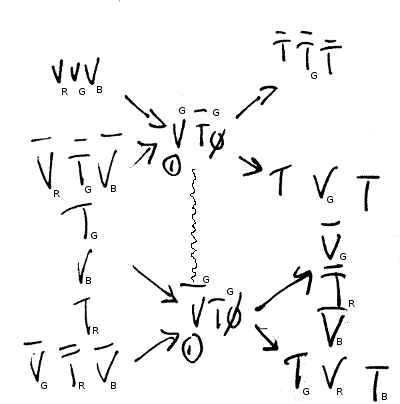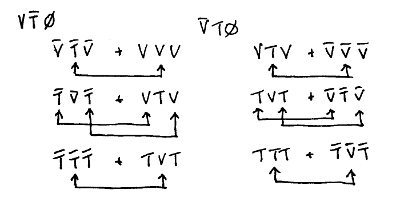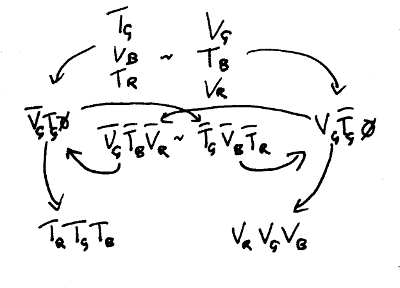Next: Proton-Neutron proximity: stability within Up: Quarks and other Elementary Previous: Higg's Boson Contents
The term "colour" is believed to refer to phases. The hypothesis currently under investigation is that a rishon triplet is actually the exact same wave present in three close physically-proximate locations, each presence separated by exactly 120 degree phases (note: "present" being the most convenient word to describe the possibility of a multi-dimensional entity having more fold-back points into a 3 dimensional perspective than would normally be considered). Two potential candidates present themselves as to how to account for T and V matter types. The first is simply that V matter has a complex component. The second is O(6) phase space using Clifford Algebra as outlined by Piotr Zencyzkowski (note: it is worth bearing in mind that the complex numbers may be expressed in Clifford Algebraic terms).
Either way, out of the two types of matter plus their anti-particles, the addition of three phases would give twelve states. How would these particles interact? Recall earlier that it was believed that a Rishon triplet is the same wave-form presented in three close positions, each 120 degrees apart. This would present a triplet that could rotate about the middle of the three points.
In the case of a six-dimensional universe (folded back to three), even particles comprised of both T and V matter would be able to remain coherent and in close proximity, as the T charge would on one cycle of the wave-form move into the other three dimensions whilst the V charged matter made its presence felt in the opposing three, and vice-versa. (Note: the exact details are unclear and the author lacks the mathematical background to provide models).
Leaving aside details of mathematical models and dimensions, the most pressing requirement is to resolve the role of colour in the phase-transitions, to ensure that the rules stack up. Recall the rule that opposing phase transforms must take place in pairs? The "colour" extension of this rule is that, because energy must be conserved, the phases (i.e. colours) must also match. It is no good for example exchanging a red T particle with a green anti-T particle: that would imply that a wave in the "T" field resonating at a specific frequency was attempting to exchange places with another wave that was 120 degrees out of phase with it. The energy to do that has to come from somewhere (read: nowhere), so it cannot happen.
What is believed to occur is best illustrated with an example. Beginning again with the simplest phase transition: neutron plus neutrino to proton and electron:
 figureneutron transition with colour (3 phases)
figureneutron transition with colour (3 phases)
|
Examining the transformation of the neutron and down quark, if the two
particles are XORed together, what remains is a green V particle and a
green anti-T particle. These two particles remain in place as part of the
V
![]() 0 phase shift. On the other side of the transformation, we assume that
the reconstruction of the particle permits the introduction of two pairs
of T and anti-T particles, each pair with red and green phase. As they both
spin about the central green particle, the order is immaterial (except as an
indicator of the direction of spin). Red could have been on the left,
blue on the right, or vice-versa.
0 phase shift. On the other side of the transformation, we assume that
the reconstruction of the particle permits the introduction of two pairs
of T and anti-T particles, each pair with red and green phase. As they both
spin about the central green particle, the order is immaterial (except as an
indicator of the direction of spin). Red could have been on the left,
blue on the right, or vice-versa.
The remaining phase-shift is deceptive in that it is there merely to switch the order of the two quarks. In doing so however the phase order of each of the three is retained. Despite the swap, after the pair of transforms the colours (phases) match up correctly. In order to ensure that the whole I-Frame retains attraction (cohesion), it is critical that not only the particle-anti-particle rule be respected (middle of end quarks attracts to ends of middle quark) but also that the phase of those particles involved in attraction also match. i.e. the middle Rishon of the left quark must match the phase of the left Rishon of the middle quark, and the middle Rishon of the right quark must match the phase of the right Rishon of the middle quark.
So although some principles of enquiry have been established there is not enough information here to deduce the full extent of colour rules, although some suspicions are beginning to form. Looking again at the Transformation Chart (Figure 5) but adding in colour, we notice something interesting:
 figurephase transition marking unchanged Rishons
figurephase transition marking unchanged Rishons
|
In each phase transition, two Rishons remain unchanged. The other four (two from each Rishon) cancel out and can thus be replaced with something completely different (as long as they are also polar opposites and of the same phase). What is fascinating is that in those phase-shifts involving the neutrino (VVV), positron (TTT) and their anti-particles it is always the central Rishon that remains in place. Only in the case of the up and down quark (and anti-up and anti-down) phase transforms is it possible to pick either the left-hand Rishon of each triplet as the "unchanging" one or the right hand Rishon of each triplet as being unchangeable.
A suspicion is therefore forming that could end up, if it is true, as being a significant discovery. The suspicion is that in all matter since the birth of the Universe, the phase of the central Rishon of all neutrinos, all electrons, all anti-neutrinos and all positrons has always been the same.
For the sake of an arbitrary but sensible choice (red-shift -120 phase, blue-shift +120 phase) we pick "green" as being that central hypothetical constant phase, and continue the analysis. The implications of this would be fascinating, because it would mean that any phase transformations involving the four identical-Rishon particles would always be green. Whether there are any implications in the sub-structure of I-Frames that guarantee that the green-phased Rishon, even when in an up or down quark, always comes out into the central place when phase-shifting into a solitary VVV or TTT particle, remains to be seen.
The next example is different from the neutron phase transform in that it involves a "gluon". Consider again the pion+ phase transform into a positron and a neutrino:
 figurepion+ simple phase transition involving colour
figurepion+ simple phase transition involving colour
|
In this example, we immediately see a problem. Consider the two phase transforms together. The fact that the gluon's temporary existence has to have two quarks with conflicting colours indicates that something is wrong with the original assumptions. sadly! It would be a fascinating universe.
Instead we are forced to review the options. Would it be reasonable for the phase (colour) of the V in each matched VT0 phase-transform pair to be the same, and likewise for T?
TODO: COMPLETE
lkcl 2016-12-29